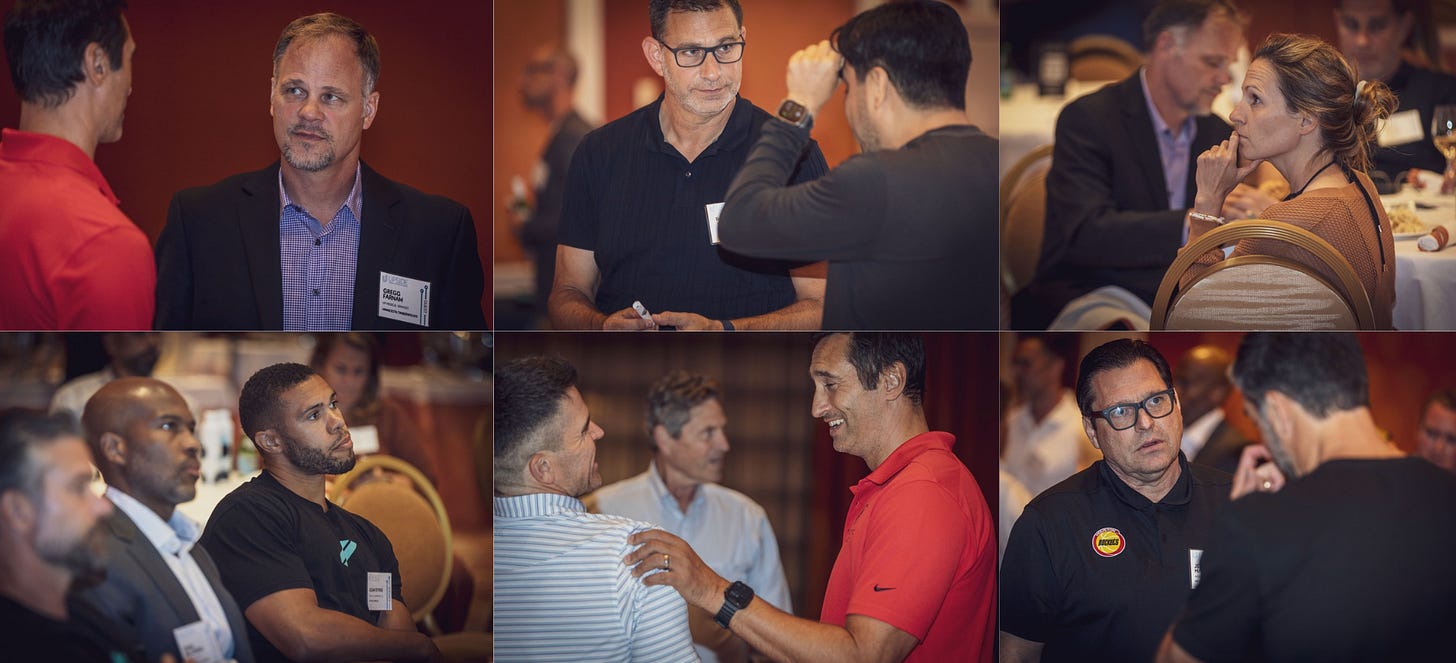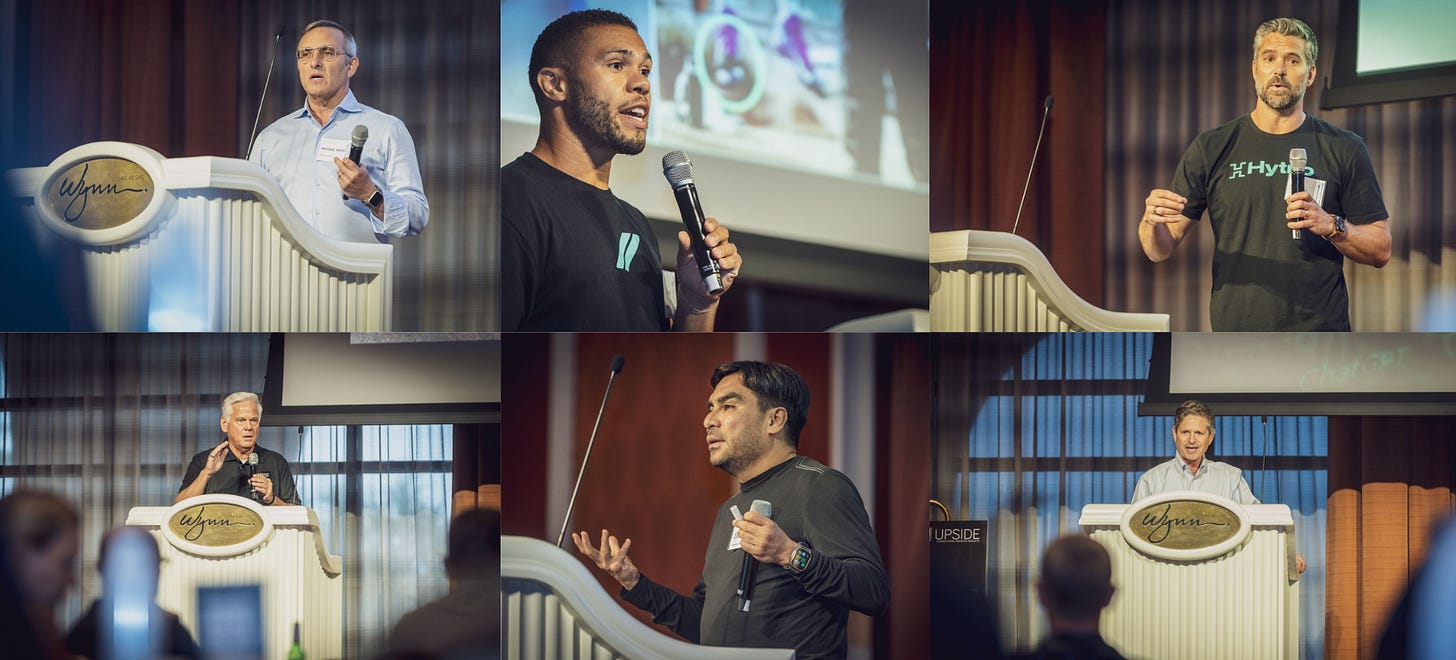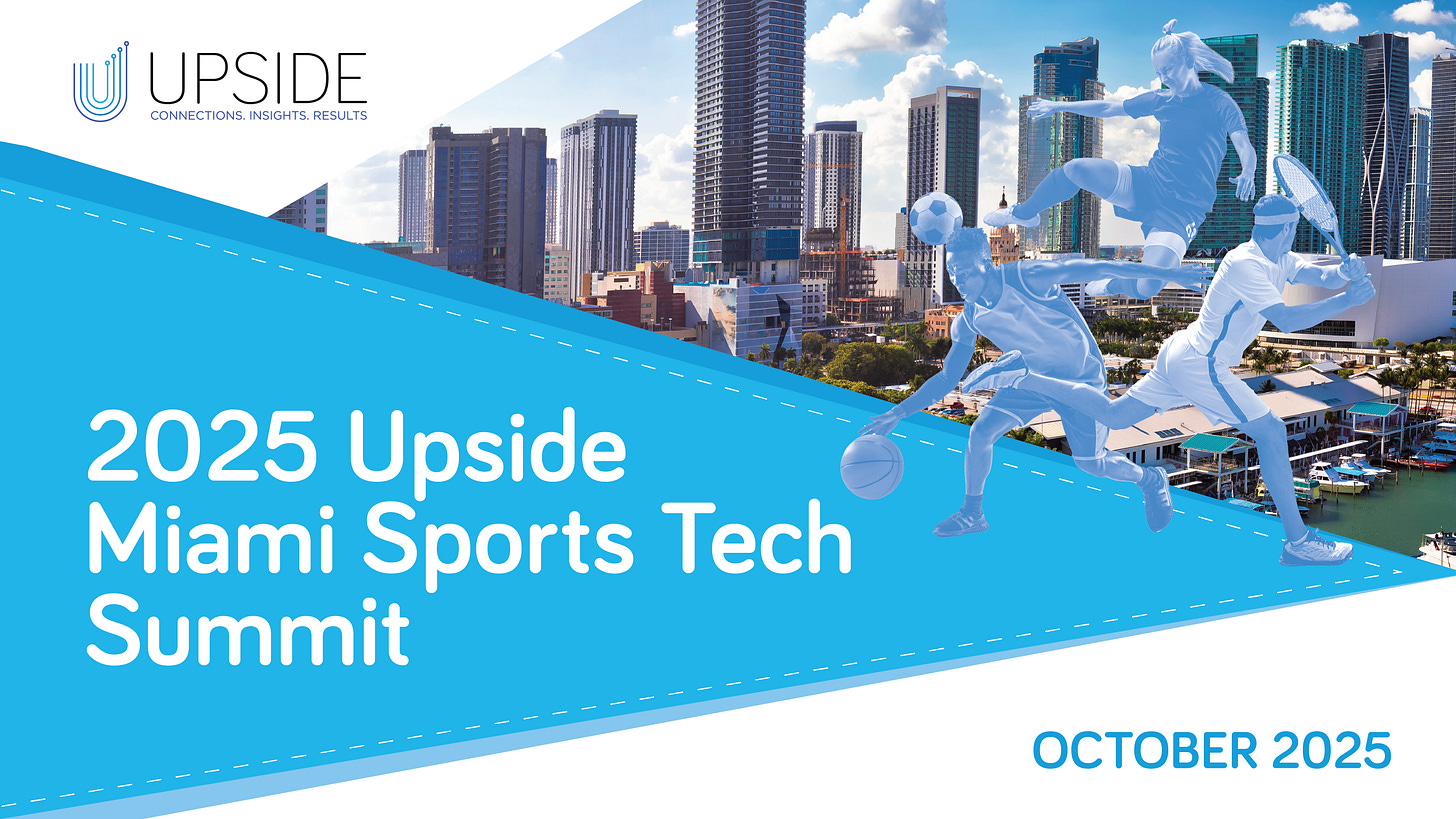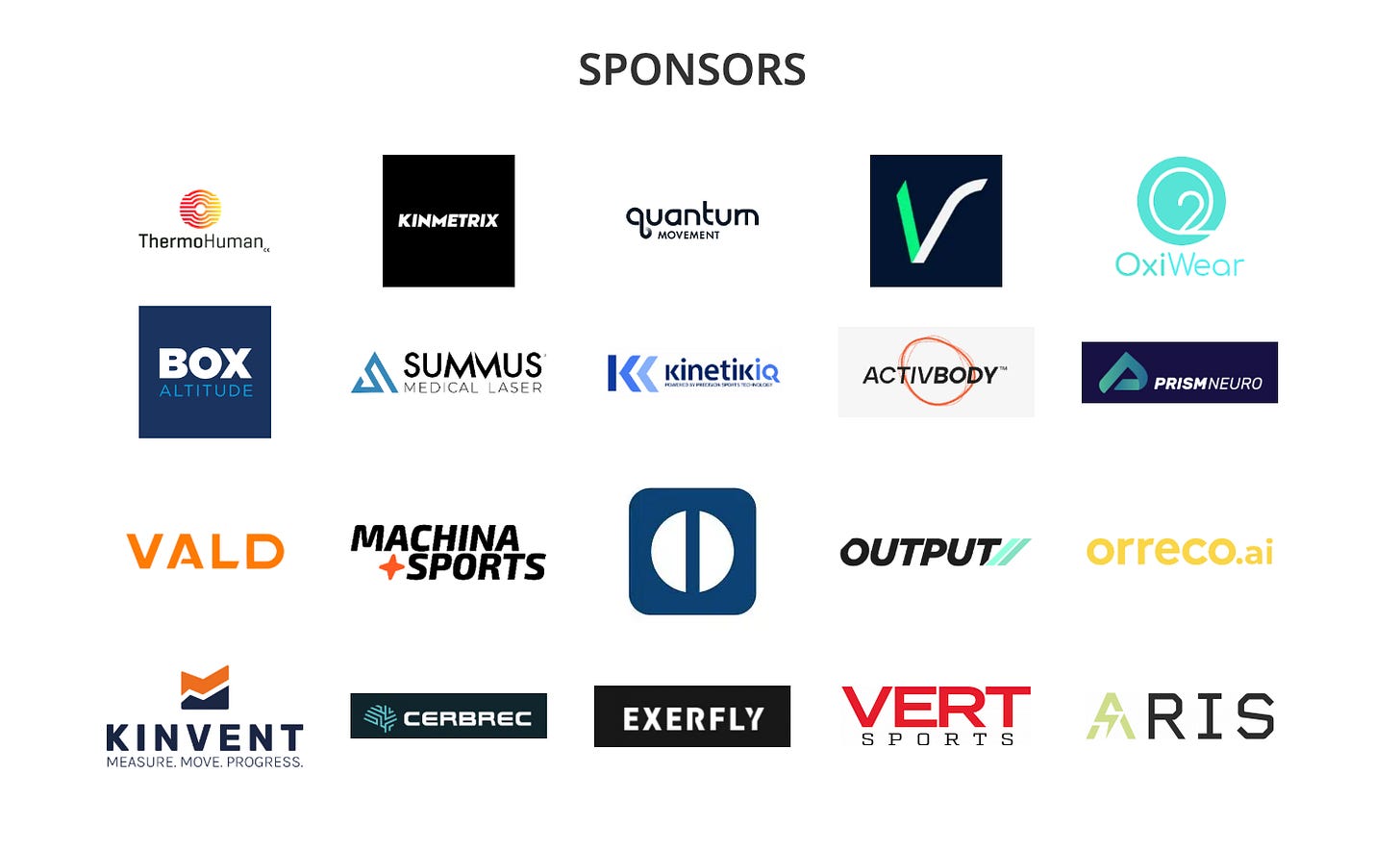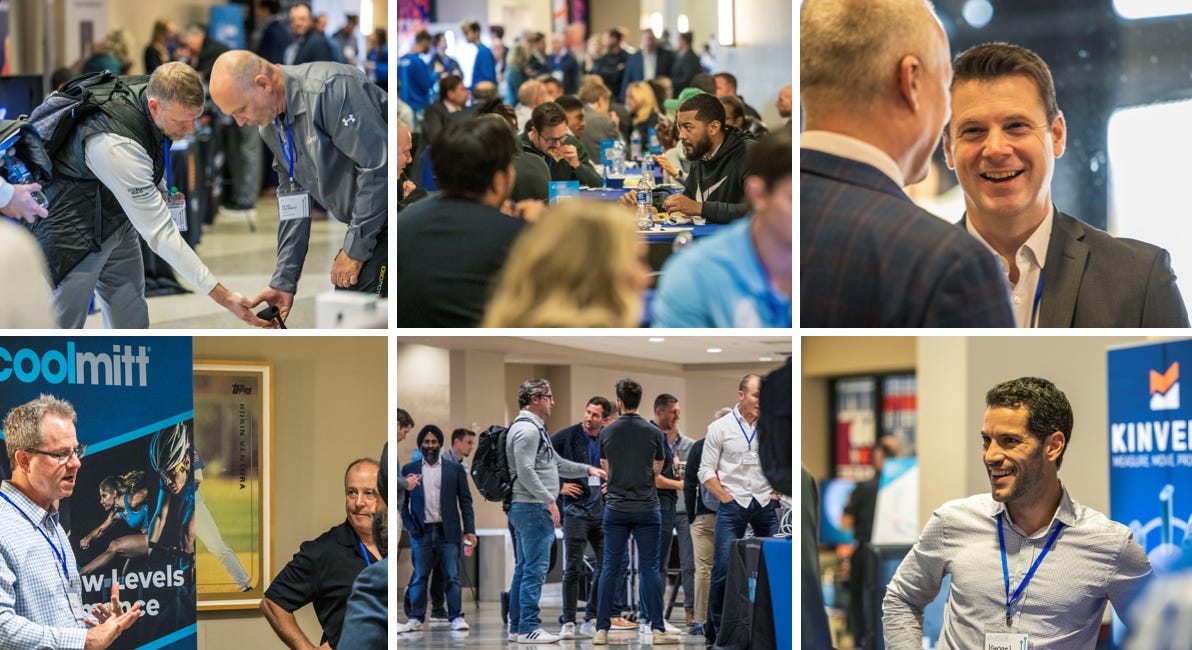🏟️ 2025 Upside VIP Dinner (NBA Summer League) Recap: Recorded Videos of Panel & Presentations. Thank you!
Dear colleague,
Thank you for attending the 2025 Upside VIP dinner at the Wynn hotel at the NBA Summer League last week. We are grateful to have hosted 40 attendees including NBA and NCAA practitioners, startup founders, and VCs. We want to thank all the great speakers that came to our 2025 VIP Dinner at the 2025 NBA Summer League:
We also want to thank our 6 sponsors and exhibitors namely Cerbrec, Hytro, MaxPlay, Nice Recovery, Output Sports and Summus Laser. Big thank you to the Upside Team for their exceptional work.
We truly appreciate you taking time out of your busy schedules to gather with us and others from the Upside community. Your presence and participation made the day a memorable and engaging experience. We hope you enjoyed the VIP Dinner and found it valuable.
Panel discussion:
Startups’ presentations:
Here is a video testimonial from NBA practitioners and startups who attended our VIP dinner and shared their experience about the dinner.
Video Highlights:
You can watch below the full videos of our opening remarks, and panel discussions and presentations by the 6 startups.
6.45 pm - 6.50 pm: Opening remarks by Julien Blin, CEO, Upside Global
6.50 pm - 7.20 pm: Panel discussion:
Participants:
Dr Marco Nunez, former head Athletic Trainer, LA Lakers (NBA)
Derek Millender, Head S&C coach, Cleveland Cavaliers (NBA)
Paul Robbins, NBA Sports performance expert, BioCore
Jordan Stewart-Mackie, Experienced Performance Scientist (NBA/EPL)
Matt Howard, Principal & former D1 player, KB Partners.
Moderator: Julien Blin, CEO, Upside Global
Here are some of the best quotes from Marco, Paul, Derek, and Matt:
1. “What’s one innovation or performance trend that’s fundamentally changing how NBA players train or recover today compared to just 3–5 years ago?”
Paul Rubbins:
“The biggest change we’ve seen recently is in the use of optical tracking technologies like Hawkeye. This is our second season using it, and the key difference now is we’re not just looking at one point on the body—we're capturing data from 29 different body locations, getting precise joint angles in real-time. Everyone talks about load management, but what we’re now really interested in is what those loads actually do to the body. Are shooting or running mechanics changing? Are there mechanical breakdowns when load or intensity spikes? This lets us go beyond the old method of saying, ‘You hit a certain load threshold, you’re done.’ Instead, we’re asking: ‘Can this athlete handle more? And if something is off, what kind of intervention do we need?’ Personally, I’m not trying to pull people back—I want them to be able to handle high loads. But this kind of tech helps us train smarter and safer.”
Marco Nunez:
“Over the last decade, and especially the past few years, there's been a massive shift from external performance tracking to internal performance metrics—things like biometrics, inflammation markers, blood analysis, and personalized nutrition. We’re now diving deeper into the individual—what they’re allergic to, how they metabolize food, what’s going on hormonally. These internal markers are becoming just as important as force plate data or GPS. We’re merging these insights together for a more complete picture of performance.”
Jordan Stewart-Mackie:
“A huge shift has been the move from just tracking on-court performance to adopting a much more holistic view. We’re now monitoring every aspect of an athlete’s life—sleep, nutrition, recovery habits, mental health—and connecting the dots. It’s not just about sprint speed or load anymore. It’s about understanding how everything in a player’s life contributes to performance. What’s interesting is this trend isn’t staying in elite sports—it’s trickling down to consumers. Sleep trackers, nutrition apps, mental health platforms—they’re all becoming mainstream because people want to understand their bodies the way pro athletes do.”
Derek Millender:
“The evolution in player mindset is huge. Three to five years ago, players weren’t coming up to us asking, ‘What was my load from yesterday’s practice?’ or ‘What’s the training objective today?’ But now, we’re seeing players walk in wanting to know this before the day starts. That’s a massive shift. And it’s a great opportunity for us as performance staff because we can have more transparent conversations. It’s no longer a push—it’s a pull. They want to know how to extend their careers, how to optimize their bodies. This level of engagement opens the door for more personalized programming and tighter synergy between players and staff.”
Matt Howard
“I’m coming at this from the investor side, so I’ve seen a lot of different technologies across different sports. What really stands out is the shift from focusing just on on-court or in-activity performance to taking a much more holistic view of the athlete. Over the past three years, there’s been a big movement toward tracking and optimizing everything—sleep, nutrition, mental health, stress—across their entire lifestyle, not just while they’re training or playing. That shift is powerful. And you’re starting to see these insights and tools trickle down from the elite level to everyday consumers. Whether it’s sleep trackers, nutrition apps, or mental wellness tools, the demand isn’t just coming from pro athletes anymore—it’s regular people who want the same level of insight into their own health. I think that crossover and the ability to personalize performance across all areas of life is one of the biggest game changers in recent years.”
2. “As the NBA continues to balance performance with player longevity, how are teams redefining the load management conversation?”
Jordan Stewart-Mackie:
“We need to reframe the entire concept of load management. It’s not about creating friction between staff and players—it’s about creating momentum. The goal is to empower players and coaches with the control to understand when and how to increase or decrease load. That starts with giving them visibility into the data and helping them interpret it—not just making decisions for them. When you put the decision-making framework in the hands of those on the front lines, it becomes less about restriction and more about optimization.”
Derek Millender:
“Internally, we use something called a ‘stress index.’ We look ahead at the schedule and proactively identify intense stretches of games. Then we ask: What can we do to keep guys performing at an optimal level throughout that period? It might be tweaking their training, adjusting recovery, or looking at movement data in our camera systems. But none of this works if we don’t loop the players in. We sit down with them and say, ‘Hey, here’s what the next few days will look like for you. Here’s what we’re monitoring. Let’s collaborate.’ That dialogue is everything. It turns the process into a partnership instead of a mandate.”
Matt Howard:
“One of the most interesting companies I saw recently was trying to optimize game scheduling based on rest, travel, and media rights. That’s where the conversation is going—scheduling itself as a performance variable. The NBA is starting to use data to create fairer, more player-friendly schedules. That’s a long way from where we were 20 years ago.”
3. “Which areas of performance tech are still underutilized but full of untapped potential?”
Paul Rubbins:
“Cognitive training is still a huge area of untapped potential. Everyone agrees it's important, but we still don’t have great solutions. Why? Because it’s hard to show objective results. Athletes are visual learners. You can show them a force plate reading and say, ‘See? You jumped higher.’ But with cognitive tools, it’s harder to demonstrate cause and effect. That makes buy-in tougher. But we know behavior starts in the brain—so we have to keep pushing in that direction.”
Jordan Stewart-Mackie:
“There’s so much complexity in the data we collect now—tons of it. And it can overwhelm both athletes and coaches. What we need is balance. Think of it as a scale: one side is internal athlete intuition, the other is external data. We have to meet teams where they are—some lean more on gut, others on numbers. But the goal is to integrate both, especially in areas like cognitive performance and mental training, which are still early in their adoption curve.”
Matt Howard (On the impact of AI in the future)
“AI is going to be the unlock. We talk all the time about how performance is 90% mental and 10% physical, but most of our tools focus on the physical. Why? Because the mental side is hard to measure. AI will change that. It will simplify data and personalize training for the individual—whether it’s for learning plays, reducing stress, or even teaching basketball IQ to a 7-year-old via gamification. That’s the missing link.”
Derek Millender
“I agree with the others on the cognitive side—there’s still so much we don’t fully understand. But I think one of the biggest challenges with cognitive tools is the lack of clear, visual feedback. Athletes are visual learners. If you put them on a force plate and show them they’re jumping higher, they get it. That creates instant buy-in. But with cognitive tech, it’s harder to see improvement. It’s not always obvious how it’s helping, and that can be a barrier. We need to find better ways to objectively show players the benefits so they feel it’s worth their time. Until we can do that, it’s going to be tough to drive full adoption. The opportunity is massive—we just haven’t quite cracked how to make it stick in a high-performance environment.”
Marco Nunez
“I agree with the others on the cognitive aspect of it. Human beings—and especially athletes—are visual learners. When it comes to human performance, if you use a force plate or strength testing and show them objective numbers—‘Hey, look, your jump height improved’—it’s an easier sell. That type of visual confirmation builds buy-in quickly. But when it comes to cognitive assessment and analysis, it’s much harder to show the impact. You can tell them it’s helping, but if they can’t see it or feel it immediately, it’s difficult for them to believe it’s making a difference. That’s the challenge. We need better tools to quantify and communicate the cognitive benefits clearly. Until we solve that, cognitive tech is always going to lag behind in adoption.”
4. “What does true player buy-in look like when introducing new technologies or recovery protocols?”
Derek Millender:
“It starts with explaining the why—and that ‘why’ isn’t one-size-fits-all. One player might buy in because he sees the career extension angle. Another might need to see immediate performance gains. So you tailor the conversation. Sometimes you don’t even start with the whole team. You start with a small cohort—maybe younger guys who aren’t in the rotation. You work with them, show results, and let others see that success. Players are always watching. If someone sees a teammate improving, they’ll say, ‘Hey, can I try that too?’ And now you’ve got cultural momentum.”
Marco Nunez:
“Buy-in is all about perceived return on investment. If players don’t feel like the testing or the tracking is helping them play better or stay healthy, you’ve lost them. That’s why it’s critical that we, as performance staff, understand each athlete on an individual level. What motivates them? What gets them to buy in? Some need hard data, others need to feel better physically. Either way, it has to connect back to performance on the court.”
Jordan Stewart-Mackie:
“For me, it's about reframing how we view the athlete. These are cerebral, intuitive human beings—many are constantly trying to learn, improve, and find an edge to get that next contract. So when we introduce a new technology or protocol, we have to start by understanding their environment, their challenges, and their support system. You can’t just drop a tool in and expect it to stick. You need to build a strategic story around it. What problem is it solving for them? In practice, what we often do is implement it with a small group—maybe in a return-to-play setting or with players who are more open to new approaches. That creates early champions. Others take notice, and that cultural momentum builds. The real magic happens when those players in the middle—the ones on the fence—see the results and become advocates themselves. That’s how you drive sustainable change.”
Paul Rubbins
“The key is showing return on investment—real, practical value. If an athlete doesn’t see how the time they’re putting into a force plate test or a blood draw is helping them get better, they’ll tune out. And that’s understandable. Our job is to know our athletes well enough to figure out what motivates them. Some are data-driven. Some need to feel better physically. Some just want to win. So we have to be flexible in how we educate them, how we show them the benefit—whether that’s through projections, analysis, or simple feedback loops. When they see that this will help them on the court, that’s when the switch flips and you’ve got true buy-in.”
5. “From an investor lens, what makes a sports tech solution truly scalable in the NBA space—and what do founders often underestimate?”
Matt Howard:
“Startups often underestimate how long it takes to get into a team and who the decision-makers are. You might finally get the right meeting three or four months in—by then, you’re burning runway and you need revenue. Most teams won’t pay for your product on day one. The key is: can you demonstrate real ROI over time? When teams renew and expand their use, that’s when you know it’s working. The ones that win are the ones who help teams work smarter, not harder.”
Paul Rubbins:
“Too many vendors bring us tools that add more complexity. We don’t need more data—we need better ways to use the data we already have. Show me the action that follows from the insight. If your product doesn’t simplify my workflow or make my job easier, it won’t last.”
Jordan Stewart-Mackie:
“The athlete is a cerebral, intuitive human being. If you want your tech to scale, you need to start with that truth. Understand their environment. Know what challenges they face, who supports them, what they’re striving for. And don’t just rely on your product—you need someone on your team who can build trust with the organization. Relationships drive adoption.”
Derek Millender:
“Be transparent. If it’s first-gen, say it. If it’s not perfect, own it. That honesty goes a long way. I’ve worked with vendors who weren’t quite there yet but were honest and communicative. That builds long-term trust, and I’ll go to bat for those people in my organization.”
Marco Nunez
“The return on investment is everything. If an athlete doesn’t see the ROI—if they’re doing force plate testing, blood analysis, biometric tracking, and they don’t understand how it helps them—they’re not going to buy in. And that’s where it gets tricky, because every athlete is different. As trainers, therapists, and strength coaches, our job is to understand each individual. What’s going to make them tick? What’s going to make them care? Whether it’s data, performance improvements, or on-court benefits, we need to tailor that communication. At the end of the day, if they believe this is going to help them perform better or stay on the court longer—that’s when the product succeeds. Founders need to understand that it's not just about the tech; it’s about the person using it.”
7.20 pm - 8.45 pm: Presentations by 6 startups with Q&As:
Thank you again for your support. It's all of you that make these events possible. We hope to see you at our new Upside event at the 2025 Upside US Summit in Sunrise in October 2025 at a world’s class sports stadium.
You can check out our 2025 Upside US Summit in Sunrise FL by clicking on the button below. We hope to see you there as well.
Some of the Participating Teams:
Location / Time:
Location: Sunrise, FL (USA) (Hosted by a Top US Pro team).
October 2025
Time: 7.30 am to 8.30 pm EST
We hope to see you there! If you are interested in attending, speaking, exhibiting, or sponsoring our 2025 Upside US Summit in Sunrise FL, feel free to email us at julien@upsideglobal.co
As always, if you have any questions, feel free to reach out to me.
Best,
You may also like:


